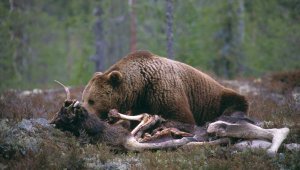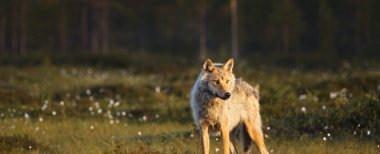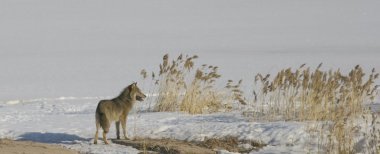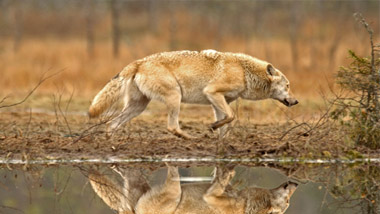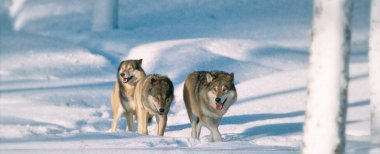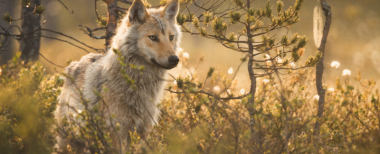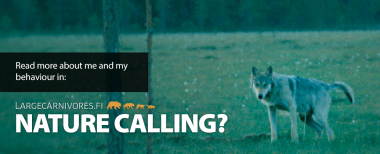Wolf hunting
Wolf hunting is only really possible when there is snow on the ground. The tracks in the snow tell the hunters where the wolves have settled for the day. When their location is known, the wolves are encircled in a circle that is large enough to ensure that the wolves are not scared off too early. When it is certain that the wolves have been completely surrounded, the encirclement is marked with flag line.
Engagement needed at the local level to implement the measures in Management Plan for the Wolf Population
Wed Mar 27 15:30:00 2019
When it comes to promoting tolerance and social acceptance of wolves, the steering group in charge of the Management Plan for the Wolf Population stressed the importance of local and regional-level projects that focus on communication, increasing awareness about wolves, and prevention of damage caused by wolves. The work of the wolf territory cooperation groups was considered very important and was mentioned as a good example of engagement at the local level. The steering group also emphasised the important role played by communication and dialogue in resolving wolf-related conflicts and increasing trust between concerned parties.
In its meeting held on 6 March, the steering group in charge of the Management Plan for the Wolf Population also discussed illegal hunting of wolves and special questions related to reindeer herding areas. Multi-species management of large carnivore and cervid populations was highlighted as an important matter in need of further development.
Multi-species population management takes into account the interdependencies and relationships between large carnivore and cervid populations as they relate to the conditions of the ecosystem in question. The approach also takes into account economic impacts, such as damage caused by cervids, as well as regional differences between ecosystems and landscape structures.
Permanent Secretary Jaana Husu-Kallio from the Ministry of Agriculture and Forestry, who chairs the steering group, highlighted the importance of taking a holistic approach to large carnivore and cervid population management.
“Different game species, such as large carnivores and cervids, must be examined at the same time and in a way that takes into account their economic and social impacts. In order to be able to do this, we need research that can be used as the basis for multi-species population management,” Husu-Kallio emphasised.
Through multi-species population management, it is possible to develop cervid population management in a way that pays better attention to the special characteristics of the area in question.
Moving toward targets and measures
The Project to update the Management Plan for the Wolf Population has now progressed to the second phase of its working plan. In addition to the opening seminar, the project has so far included eight meetings in which the preparation group has discussed jointly agreed themes and conflict areas, such as attacks by wolves on domestic animals. Now the project is moving from more general assessments toward establishing concrete targets and measures. The top priority is strengthening trust in the management, regulation and monitoring of the wolf population through broad-based cooperation.
This April, the Ministry of Agriculture and Forestry and the regional game councils will hold seven regional stakeholder meetings in different parts of Finland as part of the project to update the Management Plan. In addition to the regional game councils, representatives from local interest groups and media outlets have been invited to the meetings. The goal of the meetings is to gain regional and local perspectives and ideas on measures to be added to the updated Management Plan.
“The stakeholder meetings are important arenas for discussions on the wolf population and for coming up with solutions,” says steering group chair Jaana Husu-Kallio.
In its next meeting, the steering group will have a more detailed discussion on communication related to wolves.
Management plan for the Finnish wolf population
The population management plan for Finnish wolves approved in 2005 was the first of its kind. It was also the first wolf management plan to be renewed. The Finnish Wildlife Agency and Natural Resources Institute Finland worked together to create an updated management plan for wolf, which was then ap...
The Hunting Act and the relevant decrees
The bear, the wolf, the lynx and the wolverine are considered game animals. Legislation concerning game animals is laid out in the Hunting Act. More detailed provisions are found in the Hunting Decree, the Government Decree on Derogations Laid Down in the Hunting Act, and the species-specific Decree...
Sightings as the basis of population estimates
Natural Resources Institute Finland's (Luke) estimates on the numbers of animals are primarily based on sighting data collected by a volunteer organisation consisting of the contact persons of regional game management associations. Other utilised methods include on-the-ground censuses made by hunter...
